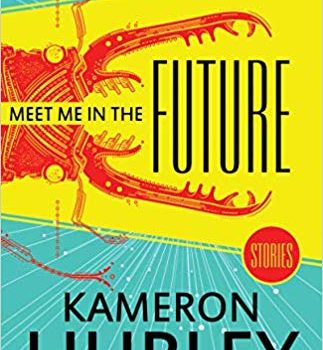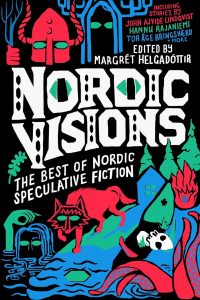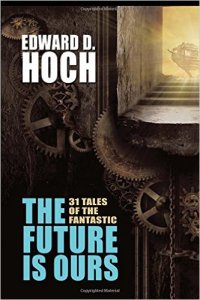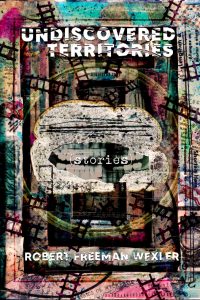Gary K. Wolfe Reviews Meet Me in the Future by Kameron Hurley
 Meet Me in the Future, Kameron Hurley (Tachyon 978-1-61696-296-8, $15.99, 332pp, tp) August 2019.
Meet Me in the Future, Kameron Hurley (Tachyon 978-1-61696-296-8, $15.99, 332pp, tp) August 2019.
Chances are that most of the futures in Kameron Hurley’s Meet Me in the Future aren’t ones you’d want to meet anyone in: plagues, endless wars, drowned cities, alien invasions, decaying spaceships, and endlessly inventive ways of disrupting the human body. Bodies, in fact, as Hurley notes in her engagingly personal introduction, seem to be a recurring preoccupation in these 16 stories (two of them short-shorts), most from the last five years. The dark, visceral energy which has also been characteristic of her novels sometimes approaches the language of body horror, and if there were a parallel term for “body SF,” Hurley would have a good claim as one of its leading practitioners. Two of the stories, for example, “Elephants and Corpses” and “The Fisherman and the Pig”, involve a “body mercenary” or “corpse jumper” who can switch into the bodies of the newly dead, which serves him well in his profession but is a lot messier than, say Richard Morgan’s “sleeves” in Altered Carbon; some of the bodies he has to deal with are a bit overripe. Even as Nev cynically views corpses as simply “vehicles” or “tools” in his violent, war-torn society, he shows a genuine fondness for his pet elephant and pet pig. Probably the purest example of the body as instrument, however, is “The Corpse Archives”, in which, on a distant planet long ago settled by humans, hideously scarred bodies serve as historical texts; it recalls the narrow but disturbing tradition of mutilation-as-narration tales that extend as far back as Kafka’s penal colony and as recent as Brian Evenson’s Last Days, and it’s one of Hurley’s most unflinching tales.
Even when Hurley explores more traditional SF themes, the vulnerabilities of the flesh are never far from the surface. “Warped Passages” is essentially a generation-starship tale, set in the cluster of ships called the Legion that shows up again in her The Stars Are Legion. But the ships themselves are organic, “a hybrid of living and dead tissue” which is not quite sentient, and their journey has been interrupted by an inexplicable space-time “anomaly,” a disc-like “wave of glutinous energy” which even bisects some of the individual ships. When the narrator somehow passes through the anomaly, an alien growth is discovered in her body, and she has to confront the likelihood that the migrants as well as the ships are being radically transformed by the journey. In “The Light Brigade”, the rather sketchy alien-war tale that provided the basis for her more fully realized novel of that title (it’s clear from the story that it needed fuller treatment), the soldiers are literally turned into light in order to be transported at lightspeed to the combat theaters. In the effectively brutal alien invasion tale “The War of Heroes”, living bodies literally become weapons, spreading plague and genetic deformities. A similar dynamic is at work in “The Plague Givers”, although that story gains its strongest effects from the developing relationship between its protagonists Lealez and the reclusive swamp-dweller Bet as they track down one of the title figures, Bet’s ex-lover. “Garda” is essentially a detective story, but it revolves around trying to uncover the provenance of a ruined body washed up on the beach.
While many of Hurley’s stories feature grim dystopian settings, the most fully worked out – and most ominous – of these is “The Sinners and the Sea”, set in a long-drowned world in which repressive Guardians enforce a government so paranoid that even writing things down is prohibited. The narrator, a disgraced Guardian reassigned as a “librarian,” eventually realizes some key truths about the world, but that moment of self-recognition is about as far as the story takes us. In fact, the generally bleak tone of Hurley’s stories derives not only from the violent, warlike societies she depicts, but from her characters’ moral paralysis; more often than not, they end up in a state of impotent defiance or resignation, such as the hostage negotiator in the bellicose, militarized society of “The Red Secretary”, who after getting her job done finds herself “transfixed on the bridge… halfway between war and peace.” It comes as something of a relief when the two most tightly focused and accomplished stories, each focusing on a single crisis of survival, offer more hopeful endings. “When We Fall” begins with the narrator, nearly crushed to death in a spaceport accident, forming a relationship with a rescue worker who later turns out to be an AI. Although, as usual, a war is impending, the two of them eventually become partners on “a war machine that is better suited to living than dying.” “Tumbledown” is a classic winter-journey survival tale of the sort that inevitably calls to mind The Left Hand of Darkness, as the protagonist Sarnai tries to make her way by dogsled across thousands of kilometers of punishing frozen wasteland on a colony planet to deliver plague serum to a remote outpost (perhaps there’s a bit of “The Cold Equations” here as well). It offers the most traditional SF problem-solving resolution of any of the stories here, but it’s also perhaps the most satisfying, as Sarnai befriends a little girl and promises to tell her “a story about the world we’ll make together.” That world sounds like a future you might want to meet someone in.
Gary K. Wolfe is Emeritus Professor of Humanities at Roosevelt University and a reviewer for Locus magazine since 1991. His reviews have been collected in Soundings (BSFA Award 2006; Hugo nominee), Bearings (Hugo nominee 2011), and Sightings (2011), and his Evaporating Genres: Essays on Fantastic Literature (Wesleyan) received the Locus Award in 2012. Earlier books include The Known and the Unknown: The Iconography of Science Fiction (Eaton Award, 1981), Harlan Ellison: The Edge of Forever (with Ellen Weil, 2002), and David Lindsay (1982). For the Library of America, he edited American Science Fiction: Nine Classic Novels of the 1950s in 2012, with a similar set for the 1960s forthcoming. He has received the Pilgrim Award from the Science Fiction Research Association, the Distinguished Scholarship Award from the International Association for the Fantastic in the Arts, and a Special World Fantasy Award for criticism. His 24-lecture series How Great Science Fiction Works appeared from The Great Courses in 2016. He has received six Hugo nominations, two for his reviews collections and four for The Coode Street Podcast, which he has co-hosted with Jonathan Strahan for more than 300 episodes. He lives in Chicago.
This review and more like it in the August 2019 issue of Locus.
 While you are here, please take a moment to support Locus with a one-time or recurring donation. We rely on reader donations to keep the magazine and site going, and would like to keep the site paywall free, but WE NEED YOUR FINANCIAL SUPPORT to continue quality coverage of the science fiction and fantasy field.
While you are here, please take a moment to support Locus with a one-time or recurring donation. We rely on reader donations to keep the magazine and site going, and would like to keep the site paywall free, but WE NEED YOUR FINANCIAL SUPPORT to continue quality coverage of the science fiction and fantasy field.








